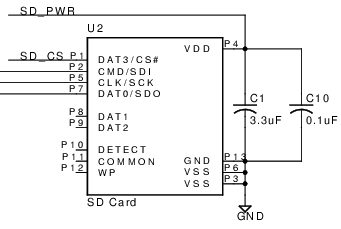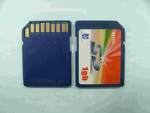


San Disk? Secure Digital.
The SD Memory Card measures a mere 24mm by 32mm by 2.1mm. There are other physical formats as well, such as microSD cards.
All SD memory and SDIO cards are required to support the older SPI/MMC mode which supports the slightly slower four-wire serial interface (clock, serial in, serial out, chip select) that is compatible with SPI ports on many microcontrollers. Many digital cameras, digital audio players, and other portable devices probably use MMC mode exclusively.
There are three transfer modes supported by SD: SPI mode (separate serial in and serial out), one-bit SD mode (separate command and data channels and a proprietary transfer format), and four-bit SD mode (uses extra pins plus some reassigned pins) to support four bit wide parallel transfers.
Low speed cards support 0 to 400 kbit/s data rate and SPI and one-bit SD transfer modes. High speed cards support 0 to 100 Mbit/s data rate in four-bit mode and 0–25 Mbit/s in SPI and one-bit SD modes. The normal transfer speed is 1.8 MB/sec.
The 4 bit mode is apparently patent protected against use in any device without paying big license fees. How freaking stupid is that? Now everyone will just use the SPI and we miss out on FAST applications.

![]()


Also:
See also:
All you need are a couple of GPIO (General Purpose I/O) pins, and you can "bit-bang" ("bit-bash") the SPI protocol used by the SD card in MMC mode. You need a clock output, a data output, and an (optional) data input. Instead of using a separate SPI data input GPIO pin, you can wire it through a current-limiting resistor to the SPI data output line, then switch I/O directions between SD/MMC reads and writes.